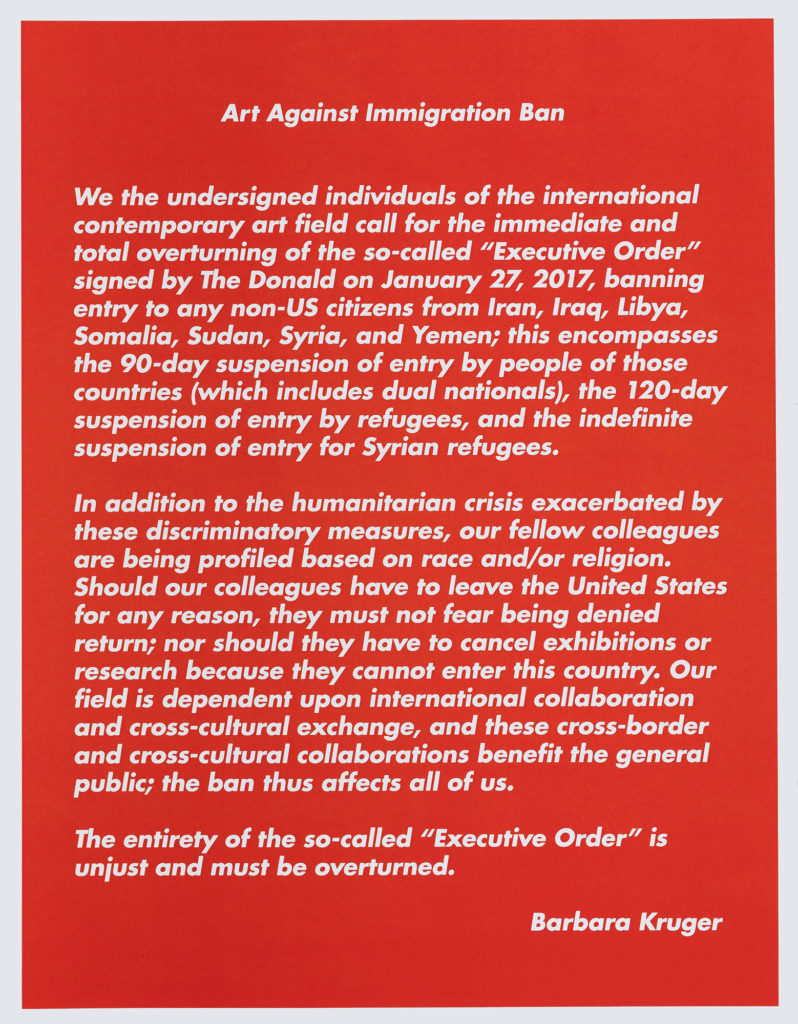Politics
Julie Mehretu and Other All-Star Artists Blast Trump’s Immigration Ban in a New Poster Campaign
Nine artists banded together to create the posters—and mail them, unsolicited, to museums across the country.

Nine artists banded together to create the posters—and mail them, unsolicited, to museums across the country.

Sarah Cascone

In recent weeks, curators at 30 leading museums across the US have been receiving surprise packages. Each one contains posters by major artists created in response to President Donald Trump’s immigration ban.
Nine artists—Joan Jonas, Barbara Kruger, Julie Mehretu, Chitra Ganesh, Liam Gillick, Walid Raad, Rirkrit Tiravanija, Danh Vo, and Anicka Yi—banded together as a collective called “Artists Against the Immigration Ban” to create the works.
Their project, which remained under wraps for months, takes on new meaning in light of the latest executive order, signed by Trump on Sunday, which bars citizens of certain, mostly Muslim-majority countries from entering the US. Unlike the two earlier travel bans, the most recent of which was set to expire over the weekend, these new restrictions are designed to be in place indefinitely.
The poster project began in February, when art historians Bettina Funcke and Amy Zion expressed their opposition to the original immigration order in a letter they posted online. The text argues that “our field is dependent on international collaboration and cross-cultural exchange” and that the ban would prevent some artists from leaving the country for fear that they would be denied re-entry.
After the letter received a strong response, “we asked the artists if they’d put the letter in their own words, if they’d rewrite it, or redesign it,” a representative for the project told artnet News.
Organizers scanned and printed the resulting posters as high-quality archival prints. Then, they mailed them—unsolicited and without warning—to leading contemporary art institutions including the Art Institute of Chicago, the San Francisco Museum of Modern Art, the Institute of Contemporary Art, Boston, and the Walker Art Center in Minneapolis.
Each package came with a cover letter asking museums to make their own judgement about what to do with its contents. “Artists don’t normally send stuff to museums out of the blue,” the representative said. “If these get accepted into collections, it means that there’s a record of this time that’s very different from a protest or an exhibition.”
The first institution to respond was New York’s Solomon R. Guggenheim Museum, which quickly shared the nine works in a blog post on the museum’s website last week.
“At certain critical junctures in American history, artists have come together to protest injustice and craft counter-narratives to the prevailing voices in government,” wrote Nancy Spector, the Guggenheim’s artistic director and chief curator, characterizing the artists’ posters as the latest in a long line of protest art, stretching back through the AIDS Crisis, demonstrations against the Vietnam War, and the Civil Rights Movement.
The new order targets Iran—with the exception of student visas—Libya, Syria, Yemen, Somalia, Chad, and North Korea, removing Sudan from the list. Venezuelan government officials and their families are also barred, while citizens of Iraq will be “subject to additional scrutiny.”
It remains to be seen how the new order will be received by the courts. Oral arguments in the Supreme Court on the constitutionality of the earlier ban were scheduled to be heard next month.
Artists involved in the poster project did not hesitate to voice their opposition to the latest version of the order. “Nothing that Trump and his lackeys do should come as a surprise,” Kruger told artnet News in an email. “When I hear people say they’re ‘shocked’ at whatever the latest episode of this manipulative and grotesquely tragic con is, it just makes my head spin. It’s that very lack of imagination that helped enable this takeover of resolute ignorance and raging white grievance.”
“And for those who didn’t vote or ‘voted their conscience,’ I would say that the world is bigger than their narcissistic conscience,” she added. “Their naive but arrogantly triumphalist kind of ideological purity and lack of strategic political thinking plus the insane blind spots and incompetence of the Democratic Party has helped bring us to this raw and brutal moment.” Kruger created her poster using her signature Futura Bold Oblique typeface, with white text on a red background.
The artist Liam Gillick, who is originally from the UK, told artnet News that the ban has changed his relationship to the US. “I wasn’t born here, but it’s my home. What you learn when you grow up outside of America, is that the country is built on immigration…. I feel nervous. The whole idea [of the travel ban] is kind of un-American in a philosophical sense and a human sense.” For his contribution, Gillick overlaid the group’s message on top of an original text, titled “A Long Sentence From an Angry White Man.”
Ganesh also wrote a text of her own to accompany the group’s message. She calls on museums to join her in denouncing the order, insisting that “part of our resistance as an arts community is to use our skills, platforms, experience, and art practices to disrupt, imagine, inspire, and above all make clear that we will do everything we can to refuse normalizing the frightening political shifts signaled by a so-called ‘Muslim ban.'”
“This order institutionalizes xenophobia and racism by targeting people entering the US based on their nationality and religion” Ganesh wrote. “This government makes it clear that it seeks to pursue policies that are antithetical to life, justice, compassion, and art… which daily embolden violence against people based on perceptions of race, gender, and economic status.”
As the country reacts to the latest iteration of the ban, the conclusion of the original letter still stands as a bold declaration: “The entirety of the Executive Order is unjust and must be overturned.”